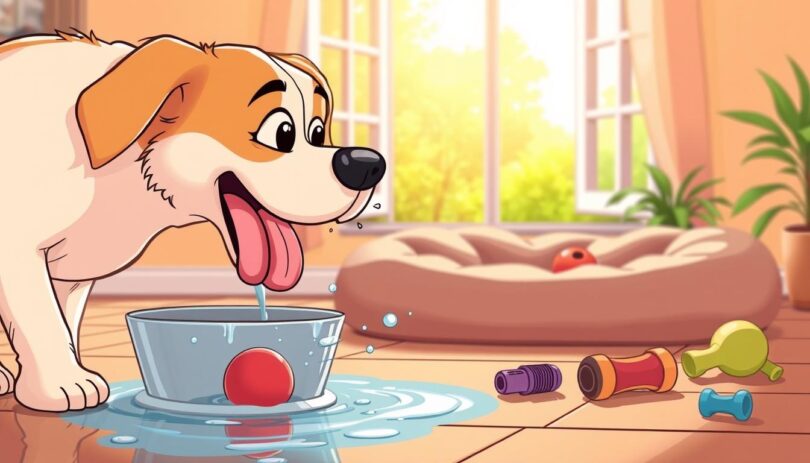A 50-pound canine requires over six cups of water daily—equivalent to filling a standard blender twice. Without proper hydration, serious health risks can develop in less than 24 hours. Fluids regulate critical bodily processes like nutrient absorption and joint protection, making dehydration far more dangerous than many realize.
Unlike humans, four-legged companions cool themselves primarily through panting. This biological difference makes them prone to overheating faster during summer walks or playtime. Their limited ability to sweat means even mild dehydration disrupts temperature control, potentially leading to organ stress.
Veterinary guidelines suggest pets drink one ounce per pound of body weight daily. Active animals or those in warm climates often need double this amount. Monitoring water bowls becomes essential, as reduced intake rarely resolves without intervention.
When a furry friend avoids their bowl, time matters. Early detection and action prevent minor issues from escalating into emergencies. This guide explores practical solutions to safeguard your companion’s well-being through informed care strategies.
Exploring Causes Behind Dog Not Drinking Water
Understanding why pets shy away from fluids involves examining physical and psychological triggers. Multiple factors—from hidden illnesses to environmental changes—can disrupt normal hydration patterns. Identifying these causes helps owners respond effectively.
Medical Conditions and Infections
Bladder infections frequently lead to reduced fluid consumption. Pets may urinate more often or have accidents indoors while avoiding their bowl. Dental problems like gum disease or cracked teeth create discomfort, turning hydration into a painful experience.
Senior animals often show less interest in liquids due to aging-related changes. Their bodies might not signal thirst properly, especially with kidney issues or metabolic diseases. Consuming spoiled food or toxins can also trigger nausea, causing immediate refusal of both food and water.
Behavioral and Environmental Factors
Water quality plays a bigger role than many realize. A pet’s keen sense of smell detects subtle changes in taste or odor from new water sources. Stressful events like moving homes or introducing new family members can also disrupt routines.
Some animals develop bowl aversions due to material preferences or placement. Stainless steel containers might feel safer than plastic ones retaining odors. Placing the dish near loud appliances could create anxiety during drinking attempts.
Recognizing Signs and Symptoms of Dehydration
How can you tell if your furry companion needs urgent hydration support? Subtle changes in behavior and physical appearance often reveal hydration status before severe complications develop. Early detection enables timely intervention, preventing minor imbalances from escalating.
Physical Indicators in Your Pet
Check skin elasticity by gently lifting the loose skin between shoulder blades. Healthy tissue snaps back instantly, while dehydrated skin forms a tent-like shape that slowly recedes. Wrinkly breeds like Bulldogs require baseline measurements when hydrated for accurate comparisons.
Examine gums for stickiness and press lightly to test capillary refill. Pink color should return within two seconds. Dry nasal tissue and sunken eyes often accompany advanced fluid loss. Reduced energy levels and excessive panting frequently appear before visible physical changes.
When to Seek Immediate Veterinary Care
Dark yellow urine or complete lack of urination signals critical fluid depletion. Weak pulse and cold extremities indicate circulatory collapse requiring emergency intervention. If skin doesn’t regain shape after three seconds or gums remain pale, contact your vet right away.
Organ failure risks increase dramatically after 24 hours without proper hydration. Professionals recommend urgent care if multiple symptoms appear simultaneously. Timely IV fluids often reverse severe cases when administered promptly.
Home Remedies and Feeding Adjustments to Encourage Fluids
Hydration challenges often require creative solutions tailored to individual preferences. Simple changes in feeding routines and environmental setups can make liquids more appealing while supporting overall health.
Enhancing Food with Added Liquids
Mix warm broth into dry kibble to soften textures and boost moisture content. This method helps pets consume extra fluids during meals without changing their diet. Low-sodium chicken or beef stock adds enticing flavors while maintaining nutritional balance.
For pets refusing bowls entirely, try offering hydration through food. Canned pumpkin (unsweetened) or bone broth ice cubes provide refreshing alternatives. These options work particularly well for animals recovering from illness or dental procedures.
Innovative Tips for Picky Drinkers
Experiment with container materials—ceramic bowls often retain fewer odors than plastic. Place multiple water stations in quiet areas away from foot traffic. Some companions prefer wide, shallow dishes that don’t touch their whiskers.
Freeze diluted Pedialyte into cubes for a electrolyte-rich treat. The cold crunchiness attracts many pets, especially during warmer months. Always keep a separate bowl of fresh water available alongside these creative solutions.
Understanding the Role of Veterinary Guidance
When hydration efforts at home fall short, professional expertise becomes vital. Veterinarians offer critical insights that bridge the gap between temporary fixes and lasting solutions. Their training helps pinpoint issues invisible to untrained eyes, ensuring pets receive tailored care.
Assessing When Professional Help is Needed
Time-sensitive decisions matter most when pets avoid liquids. If 24 hours pass without adequate intake, how long a canine can safely go without becomes a pressing concern. Emergency clinics provide round-the-clock care for severe cases, using intravenous fluids to stabilize patients rapidly.
Veterinary teams employ blood panels and imaging tools to uncover hidden conditions. These tests reveal organ function, infections, or metabolic disorders affecting thirst signals. Early intervention often prevents minor imbalances from becoming life-threatening crises.
Track consumption patterns and symptoms before your visit. Note changes in energy levels, urination frequency, or gum color. This information helps clinicians differentiate between behavioral quirks and medical emergencies. Specialists might recommend customized hydration plans based on your pet’s health history.
Never hesitate to contact your vet when uncertain. Their guidance ensures you make informed choices during critical moments. With proper care, most hydration challenges resolve successfully, letting your companion thrive again.
Moving Forward: Keeping Your Pet Hydrated and Healthy
Maintaining optimal hydration requires proactive daily habits and environmental awareness. Start by offering fresh water in multiple clean bowls placed in quiet areas. Track consumption using marked containers to ensure your companion meets their minimum ounce-per-pound body weight needs, adjusting for exercise or warmer days.
Upgrade water stations with ceramic or stainless steel bowls washed daily. Add ice cubes during summer or broth during winter to spark interest. For aging animals or busy households, consider automatic dispensers that maintain constant access while monitoring intake.
Pair hydration efforts with preventive care through annual veterinary check-ups. These visits catch early signs of dental issues or metabolic changes affecting thirst. Keep vaccination schedules current and pet-proof spaces to prevent toxin exposure that might disrupt eating patterns.
Develop a hydration journal noting daily amounts consumed and environmental factors. This record helps spot downward trends before dehydration symptoms appear. Celebrate small victories when picky drinkers try new fluids, reinforcing positive associations.
With consistent routines and attentive observation, you’ll create lasting hydration habits supporting lifelong health. Remember—preventive measures today prevent emergencies tomorrow, letting your furry friend thrive through every life stage.
FAQ
How can I check for dehydration at home?
Gently pinch the skin between your pet’s shoulder blades. If it doesn’t snap back quickly, this suggests poor skin elasticity – a key dehydration symptom. Dry gums and sunken eyes also indicate fluid loss requiring immediate attention.
Can I add flavor to water to encourage drinking?
Yes! Mix low-sodium chicken broth (avoid onion/garlic varieties) or bone broth into their bowl. For playful pups, freeze diluted broth into ice cubes. Some pets prefer running water – consider a pet fountain to spark interest.
What health issues cause reduced thirst in pets?
Kidney disease, urinary infections, dental pain, or gastrointestinal upset often decrease water intake. Senior animals may experience reduced thirst due to age-related conditions. Always consult a veterinarian if sudden changes occur.










Leave a Comment